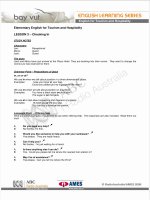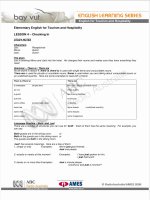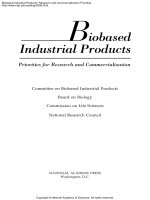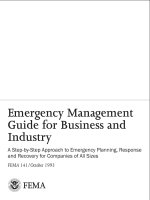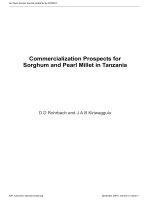Dessler HRM 12e ch 012 pay for performmance and financial incentives
Bạn đang xem bản rút gọn của tài liệu. Xem và tải ngay bản đầy đủ của tài liệu tại đây (567.93 KB, 41 trang )
Chapter 12
Pay for Performance
and Financial
Incentives
Part Four | Compensation
Copyright © 2011 Pearson Education, Inc.
publishing as Prentice Hall
PowerPoint Presentation by Charlie Cook
The University of West Alabama
WHERE WE ARE NOW…
Copyright © 2011 Pearson Education, Inc. publishing as Prentice Hall
12–2
LEARNING OUTCOMES
1. Explain how you would apply five motivation theories in
formulating an incentive plan.
2. Discuss the main incentives for individual employees.
3. Discuss the pros and cons of commissions versus
straight pay incentives for salespeople.
4. Describe the main incentives for managers and
executives.
5. Name and define the most popular organizationwide
variable pay plans.
6. Outline the steps in designing effective incentive plans.
Copyright © 2011 Pearson Education, Inc. publishing as Prentice Hall
12–3
Motivation, Performance, and Pay
• Incentives
Financial rewards paid to workers whose production exceeds a
predetermined standard.
• Frederick Taylor
Popularized scientific management and the use of financial
incentives in the late 1800s.
Systematic soldiering
Fair day’s work
• Linking Pay and Performance
Understanding the motivational
bases of incentive plans
Copyright © 2011 Pearson Education, Inc. publishing as Prentice Hall
12–4
The Hierarchy of Needs
• Maslow’s Hierarchy of Needs:
Physiological (food, water, warmth)
Security (a secure income, knowing one has a job)
Social (friendships and camaraderie)
Self-esteem (respect)
Self-actualization (becoming a whole person)
• Maslow’s prepotency process principle:
People are motivated first to satisfy each lower-order need
and then, in sequence, each of the higher-level needs.
Copyright © 2011 Pearson Education, Inc. publishing as Prentice Hall
12–5
Herzberg’s Hygiene–Motivator Theory
• Hygienes (extrinsic job factors)
Satisfy lower-level needs
Inadequate working conditions, salary, and incentive pay can
cause dissatisfaction and prevent satisfaction.
• Motivators (intrinsic job factors)
Satisfy higher-level needs
Job enrichment (challenging job, feedback, and recognition)
addresses higher-level (achievement, self-actualization) needs.
• Premise:
The best way to motivate someone is to organize the job so that
doing it provides feedback and challenge that helps satisfy the
person’s higher-level needs.
Copyright © 2011 Pearson Education, Inc. publishing as Prentice Hall
12–6
Demotivators and Edward Deci
• Intrinsically motivated behaviors are motivated by the
individual’s underlying need for competence and selfdetermination.
Offering an extrinsic reward for an intrinsically-motivated act
can conflict with the acting individual’s internal sense of
responsibility.
Some behaviors are best motivated by job challenge and
recognition, others by financial rewards.
Copyright © 2011 Pearson Education, Inc. publishing as Prentice Hall
12–7
Victor Vroom’s Expectancy Theory
• Motivation is a function of:
Expectancy: the belief that effort will lead to performance.
Instrumentality: the connection between performance and
the appropriate reward.
Valence: the value the person places on the reward.
• Motivation = (E x I x V)
If any factor (E, I, or V) is zero, then there is no motivation
to work toward the reward.
Employee confidence building and training, accurate
appraisals, and knowledge of workers’ desired rewards can
increase employee motivation.
Copyright © 2011 Pearson Education, Inc. publishing as Prentice Hall
12–8
Behavior Modification /
Reinforcement Theory
• B. F. Skinner’s Principles
To understand behavior one must understand
the consequences of that behavior.
Behavior that leads to a positive consequence (reward)
tends to be repeated, while behavior that leads to a
negative consequence (punishment) tends not to be
repeated.
Behavior can be changed by providing properly scheduled
rewards (or punishments).
Copyright © 2011 Pearson Education, Inc. publishing as Prentice Hall
12–9
Incentive Pay Terminology
• Pay-for-Performance Plan
Ties employee’s pay to the employee’s performance
• Variable Pay Plan
Is an incentive plan that ties a group or team’s pay to some
measure of the firm’s (or the facility’s) overall profitability
Example: profit-sharing plans
May include incentive plans for individual employees
Copyright © 2011 Pearson Education, Inc. publishing as Prentice Hall
12–10
Employee Incentives and the Law
• FLSA Wage Calculations and Incentive Payments
Bonuses included in overtime calculations:
Those promised to newly hired employees
Those provided for in union contracts or other agreements
Those announced to induce employees to work more
productively, steadily, rapidly, or efficiently or to induce them
to remain with the firm
Bonuses excluded from overtime calculations:
Christmas and gift bonuses not based on hours worked.
Bonuses so substantial that employees don’t consider them
a part of their wages
Purely discretionary bonuses in which the employer retains
discretion over how much, if anything, to pay
Copyright © 2011 Pearson Education, Inc. publishing as Prentice Hall
12–11
Types of Employee Incentive Plans
Individual Employee Incentive
and Recognition Programs
Sales Compensation
Programs
Pay-for-Performance
Plans
Team/Group-based
Variable Pay Programs
Organizationwide Incentive
Programs
Executive Incentive
Compensation Programs
Copyright © 2011 Pearson Education, Inc. publishing as Prentice Hall
12–12
Individual Incentive Plans
• Piecework Plans
The worker is paid a sum (“piece rate”)
for each unit he or she produces.
Straight piecework
Standard hour plan
Copyright © 2011 Pearson Education, Inc. publishing as Prentice Hall
12–13
Pros and Cons of Piecework
• Easily understandable, equitable,
and powerful incentives
• Employee resistance to changes
in standards or work processes
affecting output
• Quality problems caused by
an overriding output focus
• Possibility of violating minimum
wage standards
• Employee dissatisfaction when
incentives either cannot be earned
or are withdrawn
Copyright © 2011 Pearson Education, Inc. publishing as Prentice Hall
12–14
Individual Incentive Plans (cont’d)
• Merit Pay
Is a permanent cumulative salary increase the firm awards
to an individual employee based on his or her individual
performance
Can detract from performance if awarded across the board
Becomes permanent ongoing reward for past performance
• Merit Pay Options
Give annual lump-sum merit raises that do not make the
raise part of an employee’s base salary.
Tie merit awards to both individual and organizational
performance.
Copyright © 2011 Pearson Education, Inc. publishing as Prentice Hall
12–15
TABLE 12–1 Merit Award Determination Matrix (an Example)
Company Performance (Weight = 0.50)
Employee Performance
Rating (Weight = .50)
Outstanding
Excellent
Good
Marginal
Unacceptable
Outstanding
1.00
0.90
0.80
0.70
0.00
Excellent
0.90
0.80
0.70
0.60
0.00
Good
0.80
0.70
0.60
0.50
0.00
Marginal
—
—
—
—
—
Unacceptable
—
—
—
—
—
To determine the dollar value of each employee’s incentive award: (1) multiply the
employee’s annual, straight-time wage or salary as of June 30 times his or her maximum
incentive award and (2) multiply the resultant product by the appropriate percentage figure
from this table.
Example: if an employee had an annual salary of $20,000 on June 30 and a maximum
incentive award of 7% and if her performance and the organization’s performance were
both “excellent,” the employee’s award would be $1,120 ($20,000 × 0.07 × 0.80 = $1,120).
Copyright © 2011 Pearson Education, Inc. publishing as Prentice Hall
12–16
Incentives for Professional Employees
• Professional Employees
Are those whose work involves the application
of learned knowledge to the solution of the
employer’s problems.
Lawyers, doctors, economists, and engineers
• Possible Incentives
Bonuses, stock options and grants, profit sharing
Better vacations, more flexible work hours
Improved pension plans
Equipment for home offices
Copyright © 2011 Pearson Education, Inc. publishing as Prentice Hall
12–17
Nonfinancial and Recognition Awards
• Effects of Recognition-Based Awards
Recognition has a positive impact on performance,
either alone or in conjunction with financial rewards.
Day-to-day recognition from supervisors, peers, and
team members is important.
• Ways to Use Recognition
Social recognition
Performance-based recognition
Performance feedback
Copyright © 2011 Pearson Education, Inc. publishing as Prentice Hall
12–18
FIGURE 12–1
Social Recognition and Related Positive
Reinforcement Managers Can Use
• Challenging work assignments
• Freedom to choose own work
activity
• Being provided with ample
encouragement
• Being allowed to set own goals
• Having fun built into work
• Compliments
• More of preferred task
• Expression of appreciation in
front of others
• Role as boss’s stand-in when he
or she is away
• Note of thanks
• Role in presentations to top
management
• Employee-of-the-month award
• Job rotation
• Bigger desk
• Encouragement of learning and
continuous improvement
• Bigger office or cubicle
Copyright © 2011 Pearson Education, Inc. publishing as Prentice Hall
• Special commendation
12–19
Online and IT-Supported Awards
• Information Technology and Incentives
Enterprise incentive management (EIM)
Software that automates planning,
calculation, modeling, and management of
incentive compensation plans
Enabling companies to align their employees
with corporate strategy and goals
• Online Award Programs
Programs offered by online incentives firms that
improve and expedite the awards process
Broader range of awards
More immediate rewards
Copyright © 2011 Pearson Education, Inc. publishing as Prentice Hall
12–20
Incentives for Salespeople
• Salary Plan
Straight salaries
Best for: prospecting (finding new clients),
account servicing, training customer’s sales force,
or participating in national and local trade shows
• Commission Plan
Pay is a percentage of sales results.
Keeps sales costs proportionate to sales revenues
May cause a neglect of nonselling duties
Can create wide variation in salesperson’s income
Likelihood of sales success may be linked to external
factors rather than to salesperson’s performance
Can increase turnover of salespeople
Copyright © 2011 Pearson Education, Inc. publishing as Prentice Hall
12–21
Incentives for Salespeople (cont’d)
• Combination Plan
Pay is a combination of salary and
commissions, usually with a sizable
salary component.
Plan gives salespeople a floor
(safety net) to their earnings.
Salary component covers company-
specified service activities.
Plans tend to become complicated,
and misunderstandings can result.
Copyright © 2011 Pearson Education, Inc. publishing as Prentice Hall
12–22
Specialized Commission Plans
• Commission-plus-Drawing-Account Plan
Commissions are paid but a draw on future
earnings helps the salesperson to get through
low sales periods.
• Commission-plus-Bonus Plan
Pay is mostly based on commissions.
Small bonuses (“spiffs”) are paid for directed
activities like selling add-ons or slow-moving
items.
Copyright © 2011 Pearson Education, Inc. publishing as Prentice Hall
12–23
Maximizing Sales Force Results: Setting Sales Quotas
• Should quotas be locked in for a period of time?
• Have quotas been communicated to the sales force
within one month of the start of the period?
• Does the sales force know exactly how its quotas are set?
• Do you combine bottom-up information (like account forecasts)
with top-down requirements (like the company business plan)?
• Do 60% to 70% of the sales force generally hit their quota?
• Do high performers hit their targets consistently?
• Do low performers show improvement over time?
• Are quotas stable through the performance period?
• Are returns and debookings reasonably low?
• Has your firm generally avoided compensation-related lawsuits?
• Is 10% of the sales force achieving higher performance than previously?
• Is 5% to 10% of the sales force achieving below-quota performance
and receiving coaching?
Copyright © 2011 Pearson Education, Inc. publishing as Prentice Hall
12–24
Incentives for Managers and Executives
• Executive Total Reward Package
Base salary (cash)
Short-term incentives (bonuses)
Long-term incentives (e.g., stock options)
• Sarbanes-Oxley Act of 2002
Makes executives and the board of directors
personally liable for violating their fiduciary
responsibilities to their shareholders.
Requires the CEO and CFO to repay bonuses,
incentives, or equity-based compensation
received following issuance of a financial
statement that the firm must restate.
Copyright © 2011 Pearson Education, Inc. publishing as Prentice Hall
12–25
